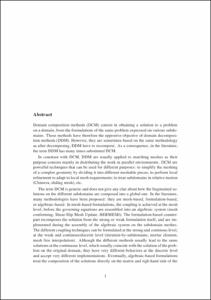Mostra el registre d'ítem simple
Parallel Implementation of Domain Composition Methods
| dc.contributor.author | Houzeaux, Guillaume |
| dc.contributor.author | Cajas García, Juan Carlos |
| dc.contributor.author | Eguzkitza, Beatriz |
| dc.contributor.author | Vázquez, Mariano |
| dc.contributor.other | Barcelona Supercomputing Center |
| dc.date.accessioned | 2016-04-05T12:38:00Z |
| dc.date.available | 2016-04-05T12:38:00Z |
| dc.date.issued | 2015-04 |
| dc.identifier.citation | Houzeaux, Guillaume [et al.]. Parallel Implementation of Domain Composition Methods. A: "See this image Techniques for Parallel, Distributed and Cloud Computing in Engineering". Stirlingshire (UK): Saxe-Coburg Publications, 2015, p. 61-92. |
| dc.identifier.isbn | 978-1874672685 |
| dc.identifier.issn | 1759-3158 |
| dc.identifier.uri | http://hdl.handle.net/2117/85206 |
| dc.description.abstract | Domain composition methods (DCM) consist of obtaining a solution to a problem on a domain, from the formulations of the same problem expressed on various subdomains. These methods have therefore the oppostive objective to domain decomposition methods (DDM). However, they are sometimes based on the same methodology as after decomposing, DDM have to recompose. As a consequence, in the literature, the term DDM has many times been substituted for DCM. In contrast to DCM, DDM are usually applied to matching meshes as their purpose consists mainly of distributing the work in parallel environments. DCM are powerful techniques that can be used for different purposes: to simplify the meshing of a complex geometry by dividing it into different meshable pieces; to perform local refinement to adapt to local mesh requirements; to treat subdomains in relative motion (Chimera, sliding mesh), etc. The term DCM is generic and does not give any clue about how the fragmented solutions on the different subdomains are composed into a global one. In the literature, many methodologies have been proposed: they are mesh-based, formulation-based, or algebraic-based. In mesh-based formulations, the coupling is achieved at the mesh level, before the governing equations are assembled into an algebraic system (mesh conforming, shear-slip mesh update, HERMESH). The formulation-based counterpart recomposes the solution from the strong or weak formulation itself, and are implemented during the assembly of the algebraic system on the subdomain meshes. The different coupling techniques can be formulated at the strong and continous level, at the weak and continous or discrete levels (iteration-by-subdomains, mortar element, mesh free interpolation). Although the different methods usually lead to the same solutions at the continuous level, which usually coincides with the solution of the problem on the original domain, they have very different behaviour at the discrete level and accept very different implementations. Eventually, algebraic-based formulations treat the composition of the solutions directly on the matrix and right-hand side of the individual subdomain algebaric systems. This chapter concentrates on the parallel implementations of some algebraic-based domain composition methods. The advantages of algebraic-based formulation over the mesh or formulation-based techniques, is that the method is relatively problem independent, its implementation can be hidden in the iterative solver operations, and the method can be made implicit and explicit relatively easily. |
| dc.format.extent | 36 p. |
| dc.language.iso | eng |
| dc.publisher | Saxe-Coburg Publications |
| dc.relation.ispartofseries | Computational Science, Engineering & Technology Series, 36 |
| dc.subject | Àrees temàtiques de la UPC::Enginyeria mecànica |
| dc.subject.lcsh | Navier-Stokes equations |
| dc.subject.other | Parallel |
| dc.subject.other | MPI |
| dc.subject.other | Domain composition method |
| dc.subject.other | Domain decomposition method |
| dc.subject.other | Finite element |
| dc.subject.other | Subdomain coupling |
| dc.subject.other | Computational mechanics |
| dc.title | Parallel Implementation of Domain Composition Methods |
| dc.type | Part of book or chapter of book |
| dc.subject.lemac | Equacions de Navier-Stokes |
| dc.identifier.doi | 10.4203/csets.36.4 |
| dc.description.peerreviewed | Peer Reviewed |
| dc.relation.publisherversion | http://www.ctresources.info/csets/chapter.html?id=569 |
| dc.rights.access | Open Access |
| dc.description.version | Postprint (author's final draft) |
| local.citation.pubplace | Stirlingshire (UK) |
| local.citation.publicationName | See this image Techniques for Parallel, Distributed and Cloud Computing in Engineering |
| local.citation.startingPage | 61 |
| local.citation.endingPage | 92 |


